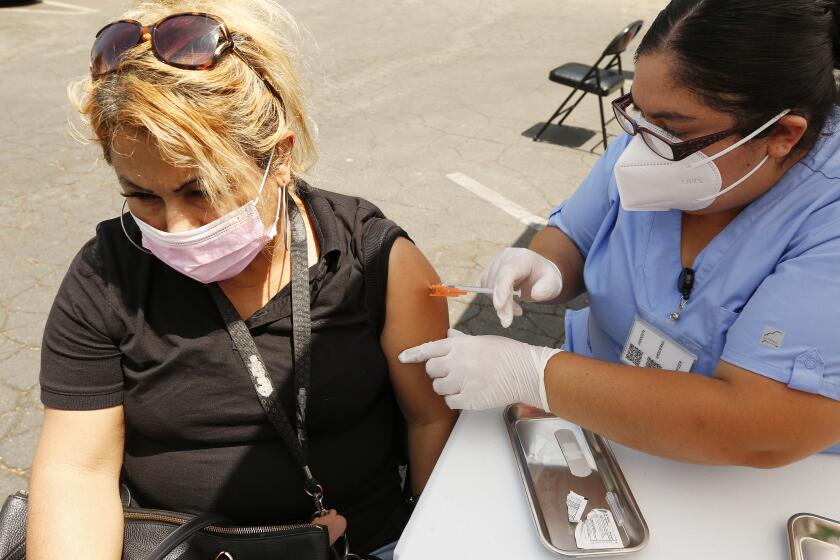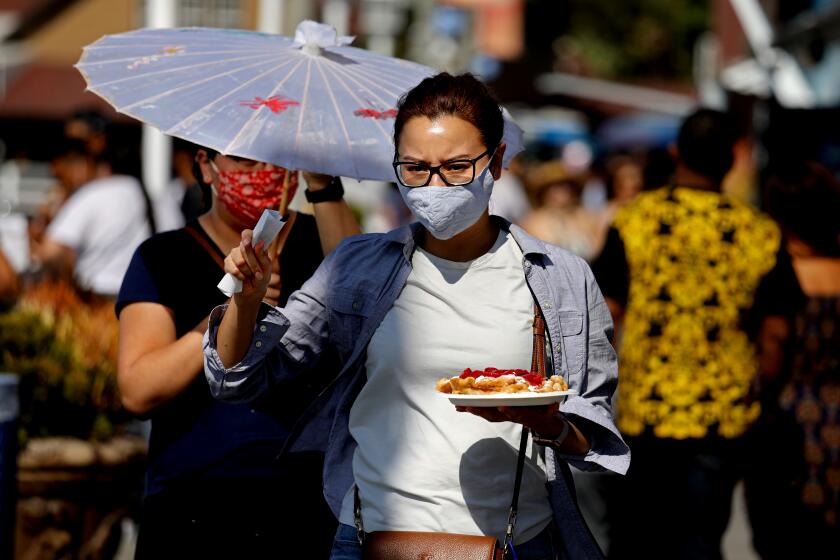States are scaling back coronavirus reporting just as cases surge

- Share via
OMAHA — Several states scaled back their reporting of COVID-19 statistics this month just as cases across the country started to skyrocket, depriving the public of real-time information on outbreaks, cases, hospitalizations and deaths in their communities.
The shift to weekly instead of daily reporting in Florida, Nebraska, Iowa and South Dakota marked a notable shift during a pandemic in which coronavirus dashboards have become a staple for Americans closely tracking case counts and trends to navigate a crisis that has killed more than 600,000 people in the U.S.
In Nebraska, the state actually stopped reporting on the virus altogether for two weeks after Gov. Pete Ricketts declared an end to the official virus emergency, forcing news reporters to file public records requests or turn to national websites that track state data to learn about COVID statistics. The state backtracked two weeks later and came up with a weekly site that provides some basic numbers.
Other governments have gone the other direction and released more information, with Washington, D.C., this week adding a dashboard on so-called breakthrough cases to show the number of residents who contracted the virus after getting vaccinated. Many states have recently gone to reporting virus numbers only on weekdays.
L.A. County hit 3,000 new coronavirus cases Friday as the surge fueled by the Delta variant worsened.
When Florida changed the frequency of its virus reporting earlier this month, officials said it made sense given the decreasing number of cases and the increasing number of people being vaccinated.
Cases started soaring soon after, and Florida earlier this week made up one-fifth of the country’s new coronavirus infections. As a result, Florida’s weekly releases — typically done on Friday afternoons — have consequences for the country’s understanding of the current summer surge, with no statewide COVID stats coming out of the virus hotspot for six days a week.
In Florida’s last two weekly reports, the number of new cases shot up from 23,000 to 45,000 and then 73,000 on Friday, an average of more than 10,000 day. Hospitals are starting to run out of space in parts of the state.
With cases rising, Democrats and other critics have urged state officials and Republican Gov. Ron DeSantis to resume daily outbreak updates.
“There was absolutely no reason to eliminate the daily updates beyond an effort to pretend like there are no updates,” said state Rep. Anna Eskamani, a Democrat from the Orlando area.
The trend of reducing data reporting has alarmed infectious disease specialists who believe that more information is better during a pandemic. People have come to rely on state virus dashboards to help make decisions about whether to attend large gatherings or wear masks in public, and understanding the level of risk in the community affects how people respond to virus restrictions and calls to get vaccinated.
“We know that showing the data to others actually is important because the actions that businesses take, the actions that schools take, the actions that civic leaders take, the actions that community leaders take, the actions that each of us individually take are all influenced by our perception of what the risk is out there,” said Dr. Kirsten Bibbins-Domingo, who leads the department of epidemiology and biostatistics at UC San Francisco.
Coronavirus infections in Los Angeles County are accelerating amid a surge that has cases and hospitalizations reaching levels not seen in months.
But reporting the numbers on a weekly basis at least still allows people to see the overall trends while smoothing out some of the day-to-day variations that come from the way cases are reported and not the actual number of new cases. And experts have long advised that it makes sense to pay more attention to the seven-day rolling average of new cases because the numbers can vary widely from one day to the next.
And Florida health officials say that they have not curtailed the sharing of data with the U.S. Centers for Disease Control and Prevention.
Maintaining daily updates on the virus does require significant resources for states. For instance, Kansas went to reporting virus numbers three times a week in May because the state health department said providing daily statistics consumed too much time for its already overwhelmed staff.
In Nebraska, officials decided that continuing to update the virus dashboard daily wasn’t the best use of state resources now, partly because there had been a steady decline in the number of views of the website, indicating less interest in the numbers, spokeswoman Olga Dack said. The state could return to providing daily updates if the governor’s office decided that was needed, she said.
“Now that Nebraska is back to normal, some of the staff that has been dedicated to the dashboard has been able to focus on some of the other important issues,” Dack said.
State health departments have a long history of providing the public regular updates on other diseases like flu and West Nile, but those viruses have none of the political baggage associated with COVID-19.
In Florida, a former health department employee was fired last year after publicly suggesting that managers wanted her to manipulate information on coronavirus statistics to paint a rosier picture. The employee, Rebekah Jones, did not allege any tampering with data, but her comments sowed doubts about the reliability of the metrics.
Infectious disease specialist Dr. David Brett-Major said that for many people, national websites such as the one run by the CDC can be a good source of data on the latest state trends and weekly updates could be OK. The World Health Organization often uses weekly updates, but he said they do that for practical data management reasons, not political ones.
He said the message Nebraska sent when it ended its dashboard that the state emergency was over and conditions were returning to normal was troubling.
“The main problem is that it reflects a disinterest in pandemic risk management,” said Brett-Major, with the University of Nebraska Medical Center in Omaha.
Janet Hamilton, executive director of the Council of State and Territorial Epidemiologists, said part of the problem is that public health officials generally don’t have sophisticated data systems so it is more labor intensive to produce the daily dashboards. Even though public health agencies have money for operations at a time when pandemic government spending is flush, they haven’t necessarily had the chance to upgrade.
“It would be great if daily reporting could be made widely available, but public health would have to be funded better to do that and right now that is just not the case,” said Hamilton.
And even in states where virus numbers aren’t being reported publicly every day, health officials are still looking at the latest data, Hamilton said.
But at a time when the delta variant is, in the words of the CDC director, “spreading with incredible efficiency,” Bibbins-Domingo said it is important that everyone can see the latest trends and understand the risks.
“Even if we know that they are available to decision makers on a daily basis, there is considerable value to providing the data to the public,” she said.
More to Read
Sign up for Essential California
The most important California stories and recommendations in your inbox every morning.
You may occasionally receive promotional content from the Los Angeles Times.












